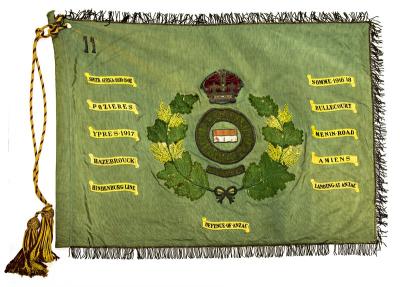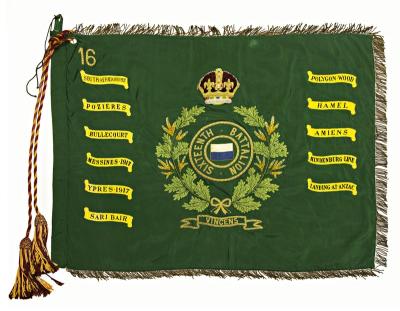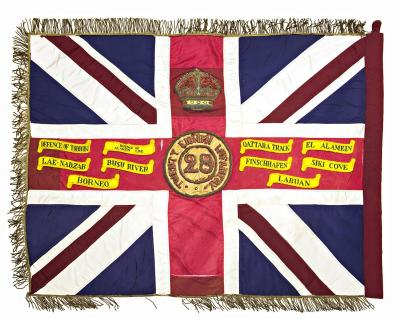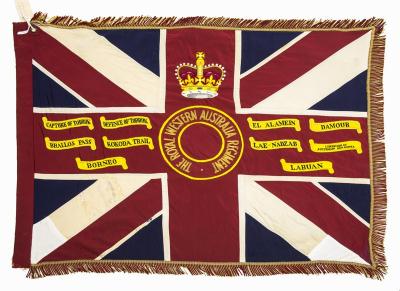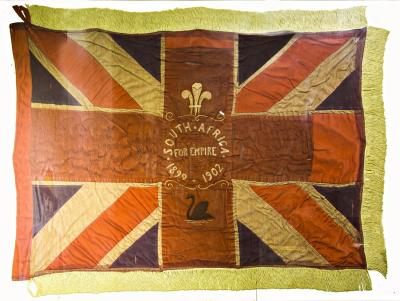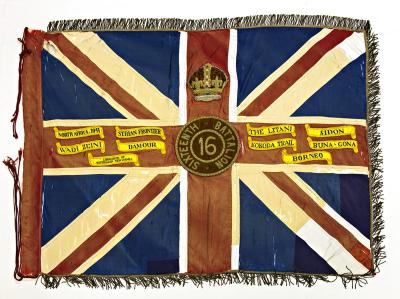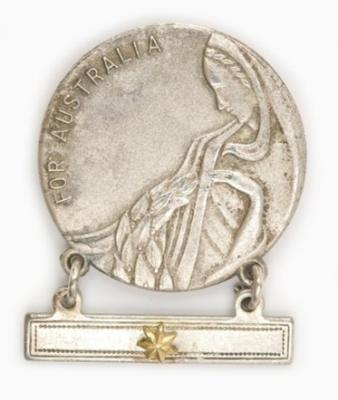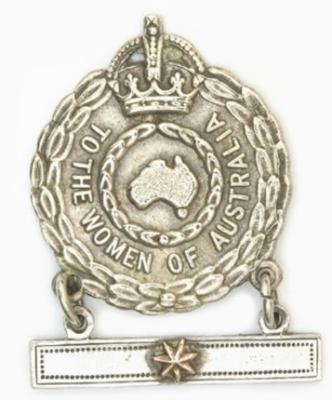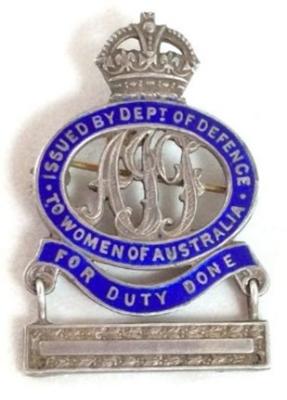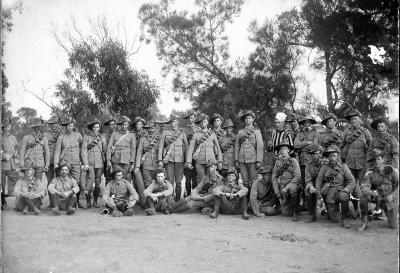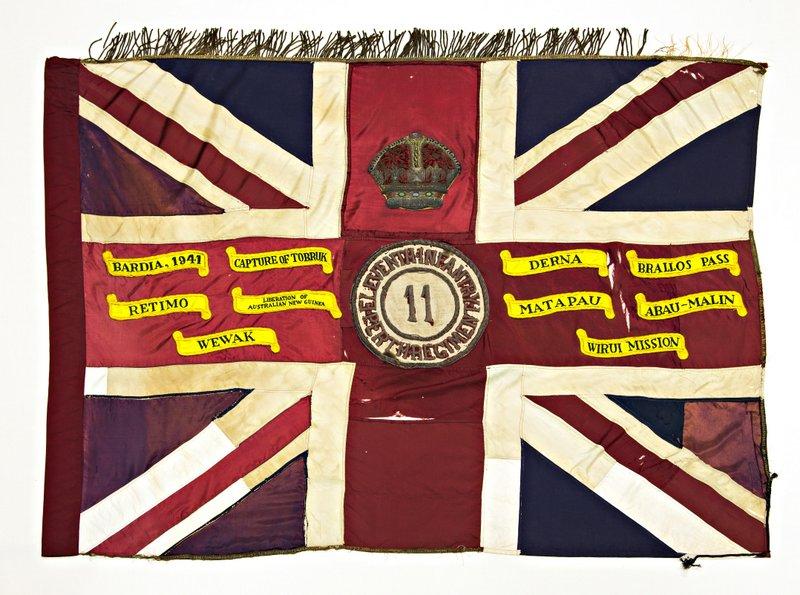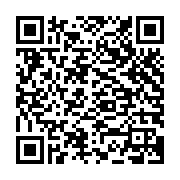11th Battalion (The City of Perth Regiment) - King's Colour (1920 Presentation)
Union flag with gold fringes. In the centre the Arabic numeral "11" on a red background within a gold circle inscribed "ELEVENTH INFANTRY - PERTH REGIMENT", surmounted by the Crown. Emblazoned on the colour are the following Second World War Battle Honours:-
BARDIA 1941, CAPTURE OF TOBRUK, DERNA, BRALLOS PASS, RETIMO, LIBERATION OF AUSTRALIAN NEW GUINEA, MATAPAU, ABAU-MALIN, WEWAK, WIRUI MISSION
This former King's Colour was originally authorised by King George V in 1919 in recognition of services of 11th Battalion (AIF) during the Great War. Presented by HE the Governor General Sir Ronald Munro-Ferguson, PC, CGMG at a parade in King's Park on 2 October 1920 and handed over to 2nd Battalion, 11th Infantry Regiment (Perth Regiment) of the Citizen Forces. In 1921 this unit became redesignated 11th Battalion (The Perth Regiment) (The title was changed to "The City of Perth Regiment" in 1933). Subsequently consecrated by the Chaplain General, Archbishop COL Riley, OBE, VD, DD at a parade on the Esplanade, Perth, 15 November 1924.
With the re-activation of the Citizen Military Forces (CMF) following the Second World War, the 11th/44th Infantry Battalion (The City of Perth Regiment) was raised as a linked battalion in 1948 to carry on the identity and traditions of the pre-war 11th and 44th Battalions respectively. The King's and Regimental Colours formerly held by these two battalions were passed on to the new battalion who paraded them in rotation on ceremonial occasions.
With the accession of HM Queen Elizabeth II to the throne in 1953, all Colours that had originally been presented as King's Colours, and were still carried by units on the current Order of Battle, were automatically deemed to be Queen's Colours.
Under major reorganisation of the CMF in 1960, all individual infantry battalions that existed at the time within each State were amalgamated to form State regiments, taking effect from 1 July 1960. Thus from that date the 11/44th, 16th and 28th Infantry Battalions were amalgamated to form The Royal Western Australia Regiment. In September 1960, at a ceremonial parade held at Northam Camp, the Colours carried by all former battalions were handed over for safe keeping by the new regiment.
Battle Honours for the Second World War were promulgated under Australian Army Order 135/1961 and the 10 selected honours approved for emblazoning on the Queen's Colour were subsequently added in 1962
These former colours were subsequently laid up in the undercroft at the State War Memorial, King's Park on 29 November 1964. These were transferred to the Army Museum of WA in 1988 as part of the Bicentenary Colours Project.
At the time of presentation this colour was a plain union flag with no central devices or other distinctions included on it. Following Military Board approval given in 1925 the centre circle and Crown were later added, in accordance with the approved design for a King's Colour.
Details
Details
Wooden Pike with Royal Crest pike head and red and gold tassels. Inscribed silver plate attached to lower portion of the pike.
This is not the correct pike, however was attached to the Queen's Colour, 11th Battalion at the time of laying up in the State War Memorial. This pike is in fact the original pike belonging to the King's Banner presented to 1st Battalion, the Western Australian Infantry Regiment in 1911. (The location of this original banner is currently unknown). Provenance of this is from the silver plate, inscribed as follows:
"Presented by His Most Gracious Majesty The king Emperor to 1st Battalion The Western Australian Infantry Regiment formerly 3rd and 4th Battalions Western Australian Infantry in recognition of services rendered to the Empire in South Africa 1901-02".
Notwithstanding the monarch at the time of presentation, the Primary Colour of an infantry battalion is referred to according to the reigning monarch. Hence all former Queen’s Colours became as a matter of protocol, King’s Colours on the accession of King Charles III on 8 September 2022.
At the time of presentation this colour was a plain union flag with no central devices or other distinctions included on it. Following Military Board approval given in 1925 the centre circle and Crown were later added, in accordance with the approved design for a King's Colour.
Open in Google Maps
Nearest geotagged records:
- 10 Light Horse Regiment - Guidon (1928 Presentation) (0km away)
- 11th Battalion (The City of Perth Regiment) - Regimental Colour (1929 Presentation) (0km away)
- 1st Battalion, 11th Australian Infantry Regiment (Perth Regiment) - King's Banner (1911 Presentation) (0km away)
- 16th Battalion (The Cameron Highlanders of Western Australia) - King's Colour (1951 Presentation) (0km away)
- 16th Battalion (The Cameron Highlanders of Western Australia) - Regimental Colour (1952 Presentation) (0km away)
- 44th Battalion (The West Australian Rifles) - King's Colour (Initial Presentation 1920) (0km away)
- 44th Battalion (The West Australian Rifles) - Regimental Colour (1927 Presentation) (0km away)
- 16th Battalion, The Royal Western Australia Regiment - Regimental Colour (1962 Presentation) (0km away)
- General Gordon Bennett's office desk, Perth College, 1942 (0km away)
- Vietnam Era, Australia, Western Australia, Fremantle, Artillery Barracks, 1969 (0km away)
Nearby places: View all geotagged records »
Australian Army Museum of Western Australia
Australian Army Museum of Western Australia
Other items from Australian Army Museum of Western Australia
- 11th Battalion (The City of Perth Regiment) - Regimental Colour (1929 Presentation)
- 16th Battalion (The Cameron Highlanders of Western Australia) - Regimental Colour (1952 Presentation)
- 28th Battalion (The Swan Regiment) - King's Colour (Initial Presentation 1920)
- 16th Battalion, The Royal Western Australia Regiment - King's Colour (1962 Presentation)
- 16th Battalion, The Royal Western Australia Regiment - Regimental Colour (1962 Presentation)
- South African War Veterans Association - Banner
- 16th Battalion (The Cameron Highlanders of Western Australia) - King's Colour (1951 Presentation)
- Mothers’ and Widows’ Badge – World War 1
- Mother's and Widow's Badge – World War 2
- Female Relative Badge World War 2
- Female Relative Badge World War 1
- World War 1, Guildford, Western Australia, Australia, Australian Field Artillery, 1914
